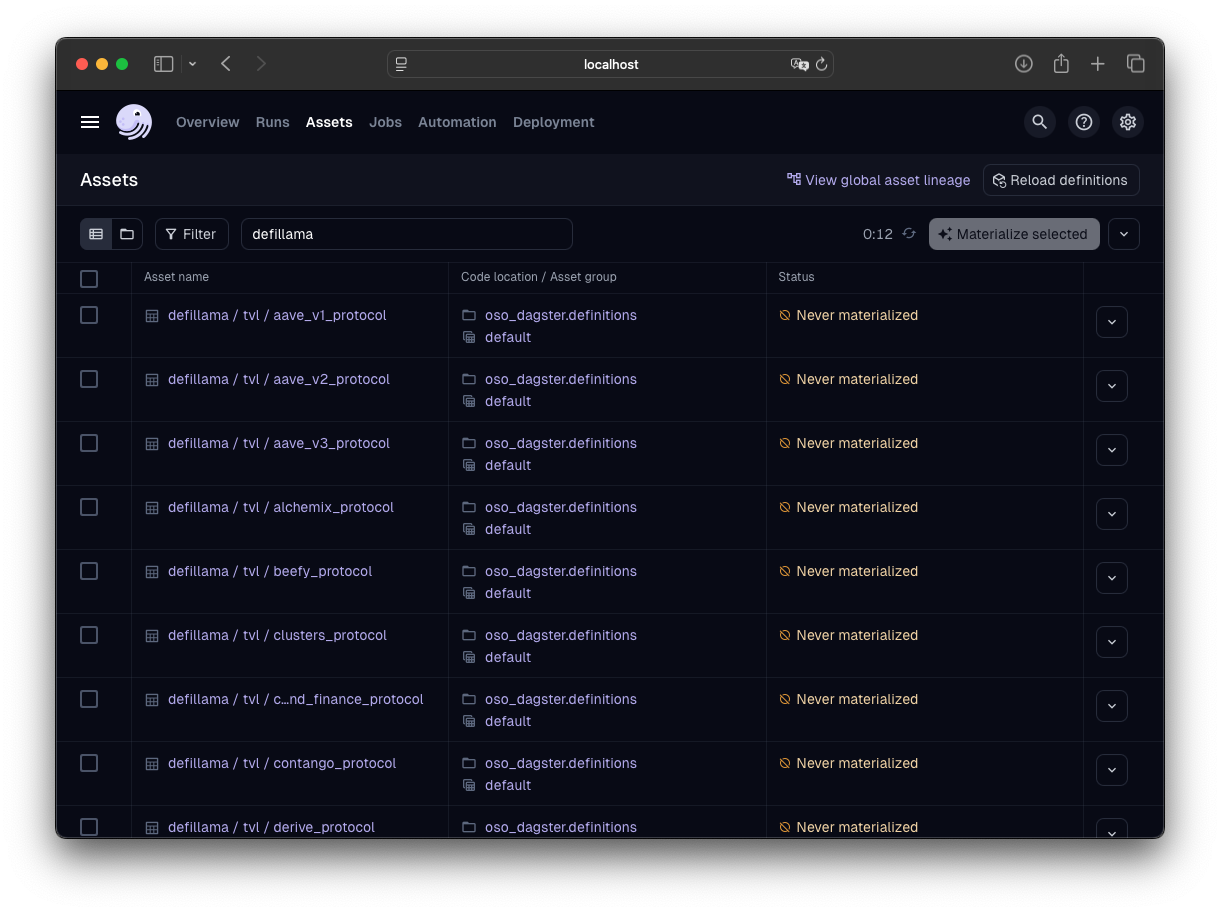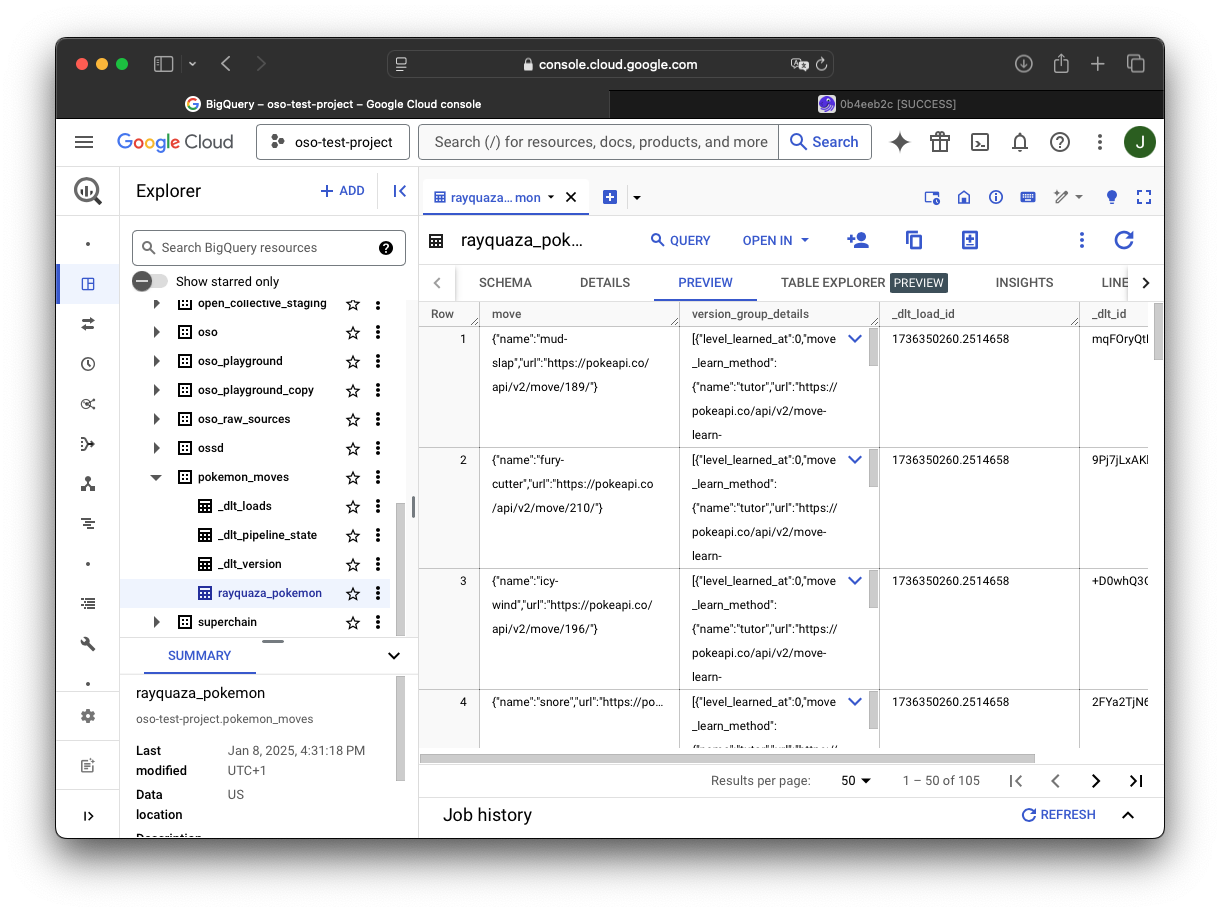Crawl an API
What Are We Trying to Achieve?
At OSO, one of the core tasks is to ingest data from various sources. This includes APIs, databases, and other data stores. In this guide, we will focus on ingesting data from REST APIs.
When you are working with APIs, you often need to write a lot of boilerplate code to fetch data, parse it, and load it into out data warehouse. This can be time-consuming and error-prone.
To make this process easier, we have created a set of tools that allow you to ingest data from APIs with minimal effort.
Here are a few reasons why this is helpful:
- Minimal boilerplate: All you do is list which endpoints you are pulling data from.
- Automatic asset creation: Each endpoint becomes its own asset, ready to be materialized in Dagster.
- Easy integration with the OSO environment: Everything is built to fit into our approach to data ingestion.
Step by Step: Defining Your API Crawler
Below is a sample showing how you can ingest data from the DefiLlama API. It retrieves data on various DeFi protocols such as Uniswap, Aave, etc.
1. List the Protocols
Pick the protocols you want. Each entry in this list represents one endpoint you will fetch.
DEFI_LLAMA_PROTOCOLS = [
"aave-v1",
"aave-v2",
"aave-v3",
"uniswap",
"velodrome",
"origin-protocol",
# ...others...
]
2. Create a Configuration Object
For the full config spec, see
dlt
documentation. Not all fields are covered here, but you can add more as needed.
Our configuration object has three main parts:
- A
clientobject, which contains the base URL and any other client-level settings. - A
resource_defaultsobject, which contains default settings for all resources. - A list of
resources, each describing a single endpoint, with a name and endpoint details.
from dlt.sources.rest_api.typing import RESTAPIConfig
config: RESTAPIConfig = {
"client": {
"base_url": "https://api.llama.fi/",
},
"resource_defaults": {
"primary_key": "id", # The field to use as the primary key
"write_disposition": "merge", # How to handle existing data
},
"resources": list(
map(
lambda protocol: {
"name": f"{protocol.replace('-', '_').replace('.', '__dot__')}_protocol",
"endpoint": {
"path": f"protocol/{protocol}",
"data_selector": "$", # Selects the whole response
},
},
DEFI_LLAMA_PROTOCOLS,
)
),
}
3. Use the Factory Function
We have a handy factory function called
create_rest_factory_asset
that takes your configuration and returns a callable factory that wires all
assets up with the specified configuration.
For a minimal configuration, we just need to supply a key_prefix to the factory
function. This will be used to create the asset keys in the Dagster environment. It
accepts a list of strings as input. Each element will be represented as a level in
the key hierarchy.
Under the hood, this will create a set of Dagster assets, managing all of
our infrastructure-specific details for you. Therefore, you can easily configure
all of them in one go. For the full reference, check
dagster
documentation.
from ..factories.rest import create_rest_factory_asset
# ... config definition ...
dlt_assets = create_rest_factory_asset(config=config)
defillama_tvl_assets = dlt_assets(key_prefix=["defillama", "tvl"])
That is it. These few lines produce a set of Dagster assets, each one pulling data from a distinct DefiLlama endpoint. When you run your Dagster job or pipeline, the data will be ingested into your OSO warehouse.
How to Run and View Results
If you have not setup your local Dagster environment yet, please follow our quickstart guide.
After having your Dagster instance running, follow the
Dagster Asset Guide to materialize the assets. Our
example assets are located under assets/defillama/tvl.

Expanding Your Crawler
In practice, you may do more than just retrieve data:
- Pagination:
dltsupports adding a paginator if you have large result sets. - Transformations: You can add transformations before loading, such as cleaning up invalid fields or renaming columns.
Our tooling is flexible enough to let you customize these details without losing the simplicity of the factory approach.
Here's a more advanced example showing automatic pagination and specific field selection using the Pokémon API:
from dlt.sources.rest_api.typing import RESTAPIConfig
from ..factories.rest import create_rest_factory_asset
POKEMON_IDS = [
"rayquaza",
"pikachu",
"charizard",
"bulbasaur",
"ditto",
"espurr",
"farfetchd",
]
config: RESTAPIConfig = {
"client": {
"base_url": "https://pokeapi.co/api/v2/",
"paginator": "json_link", # Enables automatic pagination
},
"resource_defaults": {
"write_disposition": "replace",
},
"resources": list(
map(
lambda id: {
"name": f"{id}_pokemon",
"endpoint": {
"path": f"pokemon/{id}",
"data_selector": "$.moves", # Selects only the moves field
},
},
POKEMON_IDS,
)
),
}
dlt_assets = create_rest_factory_asset(config=config)
pokemon_assets = dlt_assets(key_prefix=["pokemon", "moves"])
After running the pipeline, you'll find the Pokémon moves assets in your data warehouse:

Current limitations
Even though the factory approach is very flexible, there are some limitations you should be aware of:
- Resource Relationship: Although
dltsupports relationships between resources, the factory does not support this feature. This is because each resource is created independently, meaning that relationships between them are not inferred.
Conclusion
With just a few lines of code, you can connect OSO to any API. This method removes repetitive tasks and helps you maintain a consistent approach to ingestion. Whenever you need to add or remove endpoints, you simply update your configuration object.
Does this factory not fit your needs? You can always create your own custom asset following this guide.